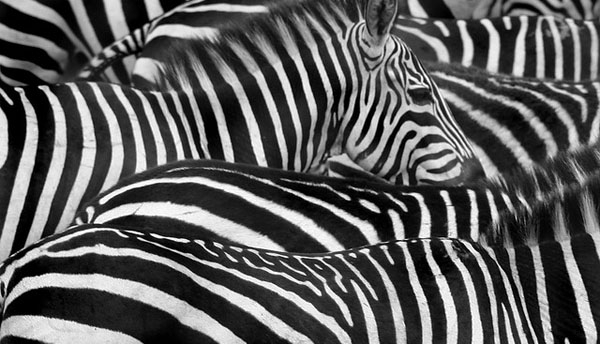Like this article?
Go on, give it a kudu!

Published on August 18 2013
Written by:
Fran
4530 views
Following years of research and observation, we today know several interesting facts about zebra stripes.Zebra stripes protect the herd from attack, but at the same time is their key to unique identification.With the difference in light reflection from zebra stripe arrangements, their stripes effectively deter biting insects and flies.Zebra stripes have fascinated humans for many years, but with the fine evolution and adaptation of pattern, design and color, zebras are perfectly at home in Africa's savannah grasslands.
Narrow, wide, white, pitch black or brown-black, neatly arranged or somewhat farther apart, zebra stripes are quite fascinating! Africa is home to three zebra types: plain zebra, Grevy’s zebra and the mountain zebra. Although not domesticated, zebras belong to the same family as horses and donkeys all belong to the same family. Highly in sync herd animals, zebras not only rely on their herd for safety and survival… but also on their stripes.
Zebras are extremely susceptible to attacks from predators. Their greatest and most feared predators are lions and hyenas. But their striped coats offer protection as they blend with their savanna environment, fairly disguised among tall savannah grasses. Apart from blending with their environment, decades of observations have revealed another major significance. The striped pattern is a greater camouflage factor than the color blending.
The zebra’s most feared predators, lion and hyena, are color blind. Thus the black and white stripes blending with the pale savannah grasslands mean little in terms of color. It is the patterns that distract, confuse, and obscure. As soon as danger is detected, zebras herd together. Collating into a large blob of patterns, the zebras succeed in confusing the predators. As the stripes blend and overlap, the lion or hyena is unable to identify a single zebra. The confusion factor is so successful that the lion or hyena can hardly determine in which direction this huge flock of pattern is moving! The herd is kept safe, and the young and weak will be saved as long as they can keep within the herd.
Interestingly enough, zebras rely on their stripes for a totally different reason as well. Each zebra has a distinct stripe arrangement and design, although it may only be a slight difference for some animals. But for the zebras, the differences are clear. Pattern arrangement variations are particularly noted on the animal’s rump. This means that zebras rely on their stripes for identifying each other. It is especially young zebras that rely on the pattern arrangements to identify their mothers. Not only does the mare and foal rely on pattern arrangements for identification, but so does individual herds. Pattern arrangements differences can help individuals find their own herds.
Apart from protection and identification, there is another way in which zebra stripes help them survive in Africa’s harsh environment. Biting insects including the dangerous tsetse fly can cause sickness and death. But it is believed that zebra stripes evolved in adaptation to this threat. It is all about reflecting light and heat: the black stripe effectively reflects light, whereas the white pattern does not. The differences in reflection not only confuses insects and flies, but are also less appealing to the insects and flies. The zebra’s black and white stripes thus positively protect against insects.
There is thus plenty behind the zebra’s stripes, much more than what meets the eye! Pattern arrangements deter predators, blurring predator vision but manage to keep families and herds together, while protecting against insect nuisances. And the acclaimed zebra stripes are bound to keep Africa’s zebras safe and sound for centuries to come.
Photo credits: some rights reserved by mobilevirgin via flickr [Creative Commons]
Mystery of zebra's stripes finally solved? By Jana J Lee for Science Now (2012)
Has been on: 11 safaris
Seeing beyond the average tourist routes and experiencing local life is my type of travel! Living in South Africa I'm an environmentalist at heart, and I continue to marvel at the beauty of the African continent.
© Your African Safari Ltd, All rights reserved.
Your African Safari is a safari-planning and safari review site. It was created to help support a healthy African wildlife population. All reviews are vetted before being approved and only ethical tours are published

Using charter flights on your next safari
Published on December 22 2025
By: yourafricansafari.com

Garamba National Park—an anchor of hope in the Democratic Republic of Congo
Published on January 09 2025
By: R.W.

Namibia imposes new visa requirements
Published on July 25 2024
By: yourafricansafari.com